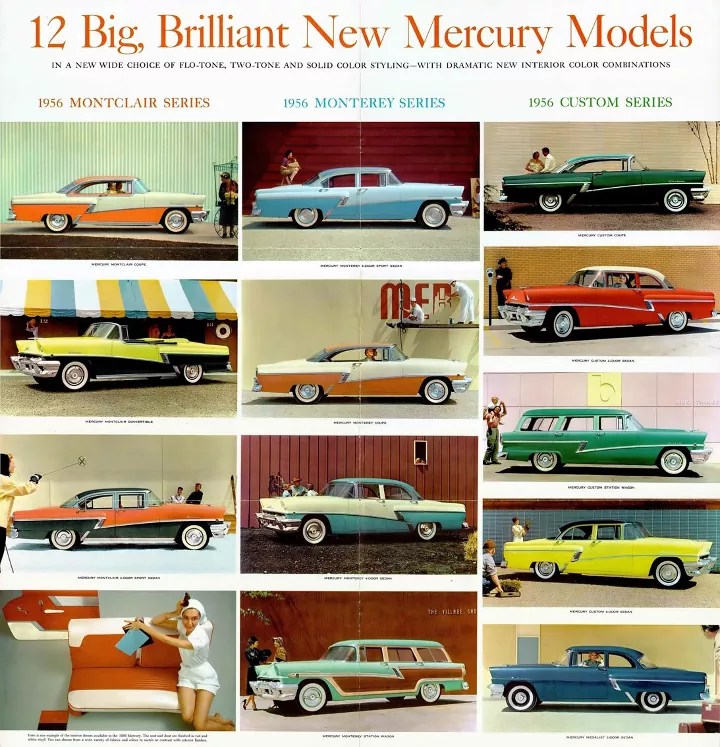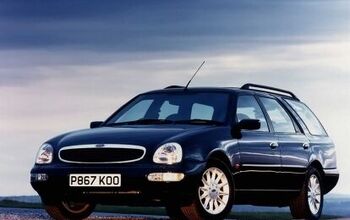Abandoned History: Ford's Cruise-O-Matic and the C Family of Automatic Transmissions (Part II)

We continue our Abandoned History coverage of the Ford Cruise-O-Matic transmission today, shortly after the three-speed automatic established itself as a reliable motivation source for Ford, Lincoln, and Mercury products. Developed by the Warner Gear division of Borg-Warner, the new automatic caught Ford up to the competition as far as an automatic offering was concerned. Efficient and economical to build, Studebaker got in on the Cruise-O-Matic action for their cars too.
After the box proved itself on Ford and Mercury cars, it spread to the luxurious ’55 Lincoln lineup where it replaced the four-speed GM Hydra-Matic. We pick up there, as efforts got underway to improve upon the original Borg-Warner design and add whiz-bang features. This entry doesn’t end up where you’d expect.
The activation method of an automatic transmission was something worth marketing in the Fifties. While levers were so boring, pushbutton automatics became all the rage. Chrysler got the jump on the other Detroit automakers when it introduced a pushbutton TorqueFlite automatic into its lineup in 1956 (we’ll have a TorqueFlite series soon). Ford decided immediately that it needed a similar feature.
Dearborn began the development of pushbutton controls of its own, which it launched under the name Keyboard Control. The feature debuted in 1957 on the Mercury line and implemented five separate buttons. Those buttons weren’t labeled how you’d expect: The longest button was at the top of the control panel as Drive. Underneath, the four smaller buttons were Brake (park), Neutral Start (neutral), Hill Control (low), and Reverse.
Those fun names lasted on Mercury cars for exactly one model year. The Keyboard Control was reworked for 1958 and renamed to Multi-Drive Keyboard Control. New labels appeared on the buttons, which then numbered six. Drive was split into Performance and Cruising, while the Park button became a lever that moved forward and backward. When pushed in the car was in park, and the buttons were locked from activation until the lever was pulled back out.
Both versions of the pushbutton automatic were a bit of a gimmick and did not prove all that popular with consumers. The system went away after 1958, and in 1959 Mercury vehicles were equipped with a ho-hum column gear selector.
While bewildered consumers pressed buttons in the Mercury showroom, transmission development carried on at Ford. The Ford-O-Matic was used as a starting point for two new transmissions Ford on their own. The company needed more versions of the three-speed as domestic passenger vehicles, in general, grew larger, sprouted fins, and carried ever greater quantities of heavy chrome.
The larger bejeweled cars weighed more and required bigger engines to push them across the country. But consumers wanted more than adequate power; the latter half of the Fifties was the unofficial start of the horsepower race in Detroit. More horses and more torque meant a need for a tougher transmission.
What Ford developed on the basis of the Ford-O-Matic were its MX and FX versions. The MX was the larger transmission, while the FX was smaller. Still three-speed automatics, both versions used the same planetary gearset as the original F-O-M but relocated the transmission’s pump from the rear to the front of the box. The MX and FX also carried a new valve body that allowed them to start in first gear in drive, rather than second.
The larger MX was destined for use in the powerful V8 vehicles from Lincoln, Mercury, and higher-end Ford cars. All MX boxes were built at Livonia Transmission (1952-present) in Michigan. FX was used only in Ford and Mercury models, and mostly in midrange offerings. The FX was made in the Fairfax Transmission plant in Cincinnati, alongside the then-dated Ford-O-Matic.
The new transmissions’ capability to start in first gear posed a branding problem for the old Ford-O-Matic. While it was technically also a three-speed, it differed in that it didn’t start in first gear like the FX and MX. Ford decided to market it as a two-speed after FX and MX debuted, which surely confused some existing owners who considered their cars a three-speed prior to 1958. Further, both new versions of the transmission were marketed under a new family name: Cruise-O-Matic.
But that wasn’t enough naming confusion, as a new version of the Ford-O-Matic arrived for the ’59 model year. It was a simpler version of the original Ford-O-Matic and used a torque converter with a compound planetary gear set. There was a multi-disc clutch at the front that handled high gear, while a band on the clutch drum handled low gear, and a band on the rear gear drum created reverse. The simplified two-speed was offered only on select Ford and Mercury models, as well as Edsel.
The world of automatic transmissions stayed in stasis at Ford for the next few years with the gen-two Ford-O-Matic, and MX and FX three-speed Cruise-O-Matics sufficient for all of the Blue Oval’s passenger cars. Elsewhere in the world, other nations were also wading into the waters of the automatic. But instead of suffering through the development of their own transmission, they stole Ford’s. Let’s talk about the Soviet Union and GAZ.
Ford Fairlane & Fairlane 500 – 1958
Gorkovsky Avtomobilny Zavod (GAZ) did have a legitimate relationship with Ford in the Twenties. In 1929 as The Great Depression approached, Ford contracted with GAZ: The brand new Russian company was to build the Model A under license. Ford supplied the engineering documents to GAZ, who set to work. The contract was via the USSR’s international commerce division, called Amtorg Trading Corporation (1924-1998). Amtorg was the first business presence the USSR had in the United States, and it was headquartered in New York City.
While Amtorg was contracted with Ford, it also contracted with Albert Kahn’s architectural firm. Kahn designed many Ford plants but was struggling for American business during the Depression. Kahn worked for Amtorg and cooperated via the company with Ford to design the very first GAZ plant in the USSR, at Niznij Novogrod. They were going to build Ford cars anyway, why not?
After cooperation with Amtorg began, Kahn helped start a government office in Moscow to help with the development of Russian architects and engineers. The office, Gosproektstroi, worked specifically with regard to widespread factory design in the established Ford and Kahn models. Top ranking staff from Kahn’s firm moved to Moscow to work at Gosproektstroi. The office was in charge of the standardization of building construction across the USSR. This activity did not go down well with many people in the United States, who quickly accused Kahn of supporting communism.
The deal with Amtorg and the USSR office didn’t last long though, as the GAZ factory was opened in November 1930, and Kahn’s contract with Amtorg ended in 1932. The first GAZ was the A – a near copy of the Model A, which then was developed into the AA pickup truck. Cooperation between GAZ and Ford lasted through 1935, and one wonders how many calls of communistic support were directed at Dearborn.
Some 20 years later, it was no surprise that when GAZ needed an automatic transmission an examination of Ford products was at the top of their to-do list. By then GAZ was among the most highly regarded automakers in Russia, with a full lineup that included executive and luxury cars for high-ranking members of the politburo, as well as off-road vehicles and trucks of varying duties. We’ll pick up our story with the GAZ translation of the Ford-O-Matic next time.
[Images: Ford]

Interested in lots of cars and their various historical contexts. Started writing articles for TTAC in late 2016, when my first posts were QOTDs. From there I started a few new series like Rare Rides, Buy/Drive/Burn, Abandoned History, and most recently Rare Rides Icons. Operating from a home base in Cincinnati, Ohio, a relative auto journalist dead zone. Many of my articles are prompted by something I'll see on social media that sparks my interest and causes me to research. Finding articles and information from the early days of the internet and beyond that covers the little details lost to time: trim packages, color and wheel choices, interior fabrics. Beyond those, I'm fascinated by automotive industry experiments, both failures and successes. Lately I've taken an interest in AI, and generating "what if" type images for car models long dead. Reincarnating a modern Toyota Paseo, Lincoln Mark IX, or Isuzu Trooper through a text prompt is fun. Fun to post them on Twitter too, and watch people overreact. To that end, the social media I use most is Twitter, @CoreyLewis86. I also contribute pieces for Forbes Wheels and Forbes Home.
More by Corey Lewis
Latest Car Reviews
Read moreLatest Product Reviews
Read moreRecent Comments
- Brian Uchida Laguna Seca, corkscrew, (drying track off in rental car prior to Superbike test session), at speed - turn 9 big Willow Springs racing a motorcycle,- at greater speed (but riding shotgun) - The Carrousel at Sears Point in a 1981 PA9 Osella 2 litre FIA racer with Eddie Lawson at the wheel! (apologies for not being brief!)
- Mister It wasn't helped any by the horrible fuel economy for what it was... something like 22mpg city, iirc.
- Lorenzo I shop for all-season tires that have good wet and dry pavement grip and use them year-round. Nothing works on black ice, and I stopped driving in snow long ago - I'll wait until the streets and highways are plowed, when all-seasons are good enough. After all, I don't live in Canada or deep in the snow zone.
- FormerFF I’m in Atlanta. The summers go on in April and come off in October. I have a Cayman that stays on summer tires year round and gets driven on winter days when the temperature gets above 45 F and it’s dry, which is usually at least once a week.
- Kwik_Shift_Pro4X I've never driven anything that would justify having summer tires.









































Comments
Join the conversation
I really like that '56 Mercury brochure. I'd never seen those cars before. It's too bad uglification took hold after that model year. I used to think I wanted the '56 Crown Victoria in high school. That was in 1973. I never found one but I was offered a '55 Bel-Aire but decided against it. It was a 4dr sedan with a six and Powerglide. It would have been a good one.
Latest auto news, reviews, editorials and podcasts
With older articles mixed in at random. Our calendar is an ungodly mess.